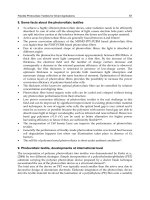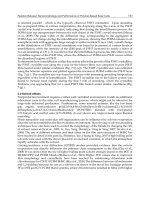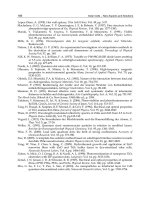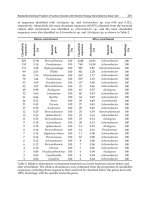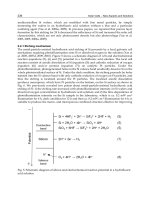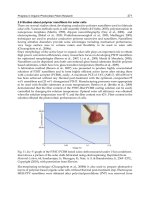Thin Film Solar Cells Fabrication, Characterization and Applications-Jef Poortmans, Vladimir Arkhipov
Bạn đang xem bản rút gọn của tài liệu. Xem và tải ngay bản đầy đủ của tài liệu tại đây (11.75 MB, 504 trang )
Thin Film Solar Cells
Fabrication, Characterization
and Applications
Edited by
Jef Poortmans
and
Vladimir Arkhipov
IMEC, Leuven, Belgium
Thin Film Solar Cells
Fabrication, Characterization
and Applications
Wiley Series in Materials for Electronic and Optoelectronic
Applications
Series Editors
Dr Peter Capper, SELEX Sensors and Airborne Systems Infrared Ltd, Southampton, UK
Professor Safa Kasap, University of Saskatchewan, Canada
Professor Arthur Willoughby, University of Southampton, Southampton, UK
Published Titles
Bulk Crystal Growth of Electronic, Optical and Optoelectronic Materials, Edited by P. Capper
Properties of Group-IV, III–V and II–VI Semiconductors, S. Adachi
Optical Properties of Condensed Matter and Applications, Edited by J. Singh
Charge Transport in Disordered Solids with Applications in Electronics, Edited by
S. Baranovski
Forthcoming Titles
Liquid Phase Epitaxy of Electronic, Optical and Optoelectronic Materials, Edited by P. Capper
and M. Mauk
Dielectric Films for Advanced Microelectronics, Edited by K. Maex, M. R. Baklanov and
M. Green
Thin Film Solar Cells
Fabrication, Characterization
and Applications
Edited by
Jef Poortmans
and
Vladimir Arkhipov
IMEC, Leuven, Belgium
Copyright
C
2006
John Wiley & Sons Ltd, The Atrium, Southern Gate, Chichester,
West Sussex PO19 8SQ, England
Telephone (+44) 1243 779777
Email (for orders and customer service enquiries):
Visit our Home Page on www.wileyeurope.com or www.wiley.com
All Rights Reserved. No part of this publication may be reproduced, stored in a retrieval system or
transmitted in any form or by any means, electronic, mechanical, photocopying, recording, scanning or
otherwise, except under the terms of the Copyright, Designs and Patents Act 1988 or under the terms of a
licence issued by the Copyright Licensing Agency Ltd, 90 Tottenham Court Road, London W1T 4LP, UK,
without the permission in writing of the Publisher. Requests to the Publisher should be addressed to the
Permissions Department, John Wiley & Sons Ltd, The Atrium, Southern Gate, Chichester, West Sussex PO19
8SQ, England, or emailed to , or faxed to (+44) 1243 770620.
Designations used by companies to distinguish their products are often claimed as trademarks. All brand names and product names used in this
book are trade names, service marks, trademarks or registered trademarks of their respective owners. The Publisher is not associated with any
product or vendor mentioned in this book.
This publication is designed to provide accurate and authoritative information in regard to the subject matter covered. It is sold on the
understanding that the Publisher is not engaged in rendering professional services. If professional advice or other expert assistance is required,
the services of a competent professional should be sought.
Other Wiley Editorial Offices
John Wiley & Sons Inc., 111 River Street, Hoboken, NJ 07030, USA
Jossey-Bass, 989 Market Street, San Francisco, CA 94103-1741, USA
Wiley-VCH Verlag GmbH, Boschstr. 12, D-69469 Weinheim, Germany
John Wiley & Sons Australia Ltd, 42 McDougall Street, Milton, Queensland 4064, Australia
John Wiley & Sons (Asia) Pte Ltd, 2 Clementi Loop #02-01, Jin Xing Distripark, Singapore 129809
John Wiley & Sons Canada Ltd, 6045 Freemont Blvd, Mississauga, Ontario, L5R 4J3
Wiley also publishes its books in a variety of electronic formats. Some content that appears in print may
not be available in electronic books.
Library of Congress Cataloging-in-Publication Data
Thin film solar cells : fabrication, characterization, and applications /
edited by Jef Poortmans and Vladimir Arkhipov.
p. cm.
Includes bibliographical references and index.
ISBN-13: 978-0-470-09126-5 (cloth : alk. paper)
ISBN-10: 0-470-09126-6 (cloth : alk. paper)
1. Solar cells. 2. Thin film devices. I. Poortmans, Jef. II. Arkhipov,
Vladimir.
TK2960.T445 2007
621.31 244—dc22
2006010650
British Library Cataloguing in Publication Data
A catalogue record for this book is available from the British Library
ISBN-10 0-470-09126-6 (HB)
ISBN-13 978-0-470-09126-5 (HB)
Typeset in 10/12pt Times by TechBooks, New Delhi, India.
Printed and bound in Great Britain by Antony Rowe, Chippenham, Wiltshire.
This book is printed on acid-free paper responsibly manufactured from sustainable forestry in which at least two trees are planted for each one
used for paper production.
Disclaimer
The publisher and the author make no representations or warranties with respect to the accuracy or completeness of the contents of this work
and specifically disclaim all warranties, including without limitation any implied warranties of fitness for a particular purpose. This work is
sold with the understanding that the publisher is not engaged in rendering professional services. The advice and strategies contained herein
may not be suitable for every situation. In view of ongoing research, equipment modifications, changes in governmental regulations, and the
constant flow of information relating to the use of experimental reagents, equipment, and devices, the reader is urged to review and evaluate
the information provided in the package insert or instructions for each chemical, piece of equipment, reagent, or device for, among other
things, any changes in the instructions or indication of usage and for added warnings and precautions.
The fact that an organization or Website is referred to in this work as a citation and/or a potential source of further information does not
mean that the author or the publisher endorses the information the organization or Website may provide or recommendations it may make.
Further, readers should be aware that Internet Websites listed in this work may have changed or disappeared between when this work was
written and when it is read. No warranty may be created or extended by any promotional statements for this work. Neither the publisher nor
the author shall be liable for any damages arising herefrom.
Dedication
The unexpected death of Vladimir Arkhipov on December 10, 2005 was a sad loss for the
scientific community and even more so for his young family. Shortly after returning from a
conference in Boston, he went to Moscow to visit his mother and while in his hometown he
suffered a heart attack. Strangely enough this happened when there was good reason to expect
that he could finally settle down in Leuven. However, his destiny was to go back to his Russian
roots. His family, friends and colleagues can only mourn the loss of a great personality and a
great scientist.
Vladimir Arkhipov was born on January 18, 1952. He studied physics at the Moscow Institute of Physics and Engineering. For his PhD, completed in 1980, he joined the theoretical
group of Professor Alexander Rudenko who stimulated his interest in the properties of semiconductors, in particular disordered inorganic materials. Their joint work on dispersive charge
transport in amorphous semiconductors featuring an exponential distribution of trap states
was well received in the literature. It attracted the interest of the international community
and started the reputation of the young scientist. For a young, gifted scientist full of ideas,
success is, indeed, an important stimulant for expanding his range of interest. Energetic as he
was, he began exploring the fascinating world of charges diffusing, drifting, and recombining
in the rough energy landscape of amorphous semiconductors, such as chalcogenides. However, by interacting with a group working on polymers he became aware that his theoretical
methodologies could be applied to organic materials as well. A new door was opened to him.
In 1992, Vladimir Arkhipov, a professor at his home institution, received a scholarship from
the German Humboldt foundation for a two years’ visit to a research group in the Department
of Physical Chemistry in Marburg, Germany. This started a very fruitful collaboration. Like
chemical bonding, such an interaction does not simply involve addition of the expertise of two
individuals but it creates a new state in which exchange interaction plays an important and
stabilizing role. His input was his profound knowledge of the theory of hopping phenomena
in amorphous solids. He did not only use it to solve problems in the course of our work on
optoelectronic properties of organic solids but he set up a comprehensive conceptual framework
for hopping transport in organic glasses and polymers featuring a Gaussian distribution of states.
Highlights included experimental and theoretical investigations on injection of charge carriers
from an electrode into the dielectric layer of a light emitting diode, the intrinsic and extrinsic
optical generation of charge carriers in conjugated polymers, charge transport in neat and doped
conjugated polymers, and thermally stimulated luminescence caused by the recombination of
geminately bound electron hole pairs. One of the last topics he dealt with was photovoltaics. He
introduced a new concept for explaining efficient charge carrier generation in organic solar cells.
Altogether Vladimir spent more than five years in Marburg, both the members of my group
and I profited greatly from daily discussions. The cooperation continued when he moved to
the Catholic University of Leuven and, after 2001, as a senior researcher to IMEC.
Over the years, Vladimir and I became personal friends. I liked his kind, gentle, warmhearted personality, his keen intellect and his intuition. He was an exceptionally good and
open-minded scientist with deep insight into the essence of a physical problem including
experiments and, above all, he was able to listen. This is one reason why the research groups
at IMEC, at the KU University of Leuven and in Marburg were so eager to interact with him,
get his advice and sit together and solve problems. It is sad that he is no longer among us. We
will miss him.
Heinz B¨assler,
University of Marburg, Germany
Contents
Series Preface
Preface
1 Epitaxial Thin Film Crystalline Silicon Solar Cells
on Low Cost Silicon Carriers
Jef Poortmans
1.1 Introduction
1.2 Deposition Technologies
1.2.1 Thermally Assisted Chemical Vapor Deposition
1.2.2 Liquid Phase Epitaxy – Electrodeposition
1.2.3 Close Space Vapor Transport Technique
1.2.4 Ion Assisted Deposition
1.2.5 Low Energy Plasma Enhanced Chemical Vapor Deposition/Electron
Cyclotron Resonance Chemical Vapor Deposition
1.3 Silicon Based Epitaxial Layer Structures for Increased Absorbance
1.3.1 Epitaxial Growth on Textured Substrates
1.3.2 Silicon–Germanium Alloys
1.3.3 Germanium–Silicon Structures
1.3.4 Epitaxial Layers on a Buried Backside Reflector
1.4 Epitaxial Solar Cell Results and Analysis
1.4.1 Laboratory Type Epitaxial Solar Cells
1.4.2 Industrial Epitaxial Solar Cells
1.4.3 Special Epitaxial Solar Cell Structures
1.5 High Throughput Silicon Deposition
1.5.1 Chemical Vapor Deposition Reactor Upscaling
1.5.2 Liquid Phase Epitaxy Reactor Upscaling
1.6 Conclusions
References
2 Crystalline Silicon Thin Film Solar Cells on Foreign Substrates by High
Temperature Deposition and Recrystallization
Stefan Reber, Thomas Kieliba, Sandra Bau
2.1 Motivation and Introduction to Solar Cell Concept
2.2 Substrate and Intermediate Layer
Thin Film Solar Cells Edited by J. Poortmans and V. Arkhipov
C 2006 John Wiley & Sons, Ltd
xiii
xv
1
1
4
5
6
8
9
10
11
11
12
15
17
21
21
22
24
24
25
29
32
32
39
39
42
viii
CONTENTS
2.2.1 Substrate
2.2.2 Intermediate Layer
2.3 Zone Melting Recrystallization
2.3.1 Introduction
2.3.2 Zone Melting Recrystallization Film Growth
2.3.3 Features of Silicon Layers Recrystallized by Zone Melting
Recrystallization
2.3.4 Development of Lamp Heated Zone Melting Recrystallization Processors
2.3.5 Zone Melting Recrystallization on Ceramic Substrates
2.4 Silicon Deposition
2.4.1 Requirements of Silicon Deposition for Photovoltaics
2.4.2 Some Basics on Thermal Silicon Atmospheric Pressure Chemical
Vapor Deposition from Chlorosilanes
2.4.3 R&D Trends in Silicon Atmospheric Pressure Chemical Vapor
Deposition for Photovoltaics
2.4.4 Silicon Chemical Vapor Deposition on Ceramic Substrates
2.5 Solar Cells on Foreign Substrates
2.5.1 Options for Solar Cell Fabrication
2.5.2 Solar Cells on Model Substrates
2.5.3 Solar Cells on Low Cost Substrates
2.6 Summary and Outlook
Acknowledgments
References
3 Thin Film Polycrystalline Silicon Solar Cells
Guy Beaucarne, Abdellilah Slaoui
3.1 Introduction
3.1.1 Definition
3.1.2 Why Polycrystalline Thin Film Silicon Solar Cells?
3.2 Potential of Polysilicon Solar Cells
3.2.1 Light Confinement
3.2.2 Diffusion Length
3.2.3 Modeling
3.3 Substrates for Polysilicon Cells
3.4 Film Formation
3.4.1 Initial Step for Grain Size Enhancement
3.4.2 Techniques for Active Layer Formation
3.4.3 Defect Density and Activity
3.5 Solar Cell and Module Processing
3.5.1 Device Structure
3.5.2 Junction Formation
3.5.3 Defect Passivation
3.5.4 Isolation and Interconnection
3.6 Polysilicon Solar Cell Technologies
3.6.1 Solid Phase Crystallization Heterojunction with Intrinsic Thin Layer
Solar Cells
3.6.2 Surface Texture and Enhanced Absorption with Back Reflector
Solar Cells
42
44
48
48
51
53
59
64
66
67
68
71
73
75
76
78
82
85
87
87
97
97
97
98
98
98
99
100
101
103
103
106
112
115
115
117
118
118
120
120
121
CONTENTS
3.6.3 Crystalline Silicon on Glass Technology
3.6.4 Other Research Efforts Around the World
3.7 Conclusion
References
ix
121
122
123
123
4 Advances in Microcrystalline Silicon Solar Cell Technologies
Evelyne Vallat-Sauvain, Arvind Shah and Julien Bailat
4.1 Introduction
4.2 Microcrystalline Silicon: Material Fabrication and Characterization
4.2.1 Microcrystalline Silicon Deposition Techniques
4.2.2 Undoped Microcrystalline Layers
4.2.3 Doped Layers
4.3 Microcrystalline Silicon Solar Cells
4.3.1 Light Management Issues
4.3.2 Single Junction Microcrystalline Silicon Solar Cells
4.3.3 Tandem Amorphous/Microcrystalline Silicon Solar Cells: The
Micromorph Concept
4.4 Conclusions
References
133
5 Advanced Amorphous Silicon Solar Cell Technologies
Miro Zeman
5.1 Introduction
5.2 Overview of Amorphous Silicon Solar Cell Technology Development and
Current Issues
5.2.1 1970s
5.2.2 1980s
5.2.3 1990s
5.2.4 After 2000
5.2.5 Current Technology Issues
5.3 Hydrogenated Amorphous Silicon
5.3.1 Atomic Structure
5.3.2 Density of States
5.3.3 Models for the Density of States and Recombination–Generation
Statistics
5.3.4 Optical Properties
5.3.5 Electrical Properties
5.3.6 Determination of Density of States
5.3.7 Metastability
5.3.8 Hydrogenated Amorphous Silicon from Hydrogen Diluted Silane
5.3.9 Doping of Hydrogenated Amorphous Silicon
5.3.10 Alloying of Hydrogenated Amorphous Silicon
5.4 Deposition of Hydrogenated Amorphous Silicon
5.4.1 Radio Frequency Plasma Enhanced Chemical Vapor Deposition
5.4.2 Direct Plasma Enhanced Chemical Vapor Deposition Techniques
5.4.3 Remote Plasma Enhanced Chemical Vapor Deposition Techniques
5.4.4 Hotwire Chemical Vapor Deposition
173
133
134
134
137
147
148
149
154
159
163
165
173
174
174
174
174
175
175
177
177
179
180
181
183
187
190
192
194
196
197
198
200
202
203
x
CONTENTS
5.5 Amorphous Silicon Solar Cells
5.5.1 Hydrogenated Amorphous Silicon Solar Cell Structure
5.5.2 Hydrogenated Amorphous Silicon Solar Cell Configurations
5.5.3 Design Approaches for Highly Efficient Solar Cells
5.5.4 Light Trapping and Transparent Conductive Oxides
5.5.5 Degradation of Hydrogenated Amorphous Silicon Solar Cells
5.5.6 Multijunction Hydrogenated Amorphous Silicon Solar Cells
5.6 Performance and Fabrication of Hydrogenated Amorphous Silicon
Based Modules
5.6.1 Energy Yield
5.6.2 Fabrication of Hydrogenated Amorphous Silicon Based
Modules
5.6.3 Plasma enhanced Chemical Vapor Deposition Systems
5.7 Applications
5.8 Outlook
Acknowledgments
References
204
204
207
208
209
211
212
6 Chalcopyrite Based Solar Cells
Martha Ch. Lux-Steiner
6.1 Introduction
6.2 Potential of Chalcopyrite Photovoltaic Modules
6.3 Technology for the Preparation of Chalcopyrite Solar Cells and Modules
6.3.1 Absorber
6.3.2 Contacts
6.4 Characterization and Modeling
6.4.1 Cell Concept
6.4.2 Carrier Density and Transport
6.4.3 Loss Mechanisms
6.5 Scaling Up and Production
6.5.1 Cost Estimations
6.5.2 Module Performance
6.5.3 Sustainability
6.6 Developing Future Chalcopyrite Technology
6.6.1 Lightweight and Flexible Substrates
6.6.2 Cadmium Free Cells
6.6.3 Indium Free Absorbers
6.6.4 Novel Back Contacts
6.6.5 Bifacial Cells and Superstrate Cells
6.6.6 Nonvacuum Processing
6.6.7 Wide Gap and Tandem Cells
References
237
7 Cadmium Telluride Thin Film Solar Cells: Characterization, Fabrication
and Modeling
Marc Burgelman
7.1 Introduction
219
221
223
223
227
229
230
230
237
237
239
240
244
247
248
250
251
254
257
258
259
260
260
261
263
263
263
264
265
266
277
277
CONTENTS
7.2 Materials and Cell Concepts for Cadmium Telluride Based Solar Cells
7.2.1 Optical Properties of Cadmium Telluride
7.2.2 Electrical Properties of Cadmium Telluride
7.2.3 The Buffer Material: Cadmium Sulfide
7.2.4 Window Materials for Cadmium Telluride Based Solar Cells
7.3 Research Areas and Trends in Cadmium Telluride Solar Cells
7.3.1 The Activation Treatment of Cadmium Telluride
7.3.2 The Back Contact Structure
7.3.3 Environmental Issues
7.3.4 Other Research Areas and Trends
7.4 Fabrication of Cadmium Telluride Cells and Modules
7.4.1 Deposition Methods for Cadmium Telluride Based Solar Cells
7.4.2 Design of Series Integrated Cadmium Telluride Modules
7.4.3 Production of Cadmium Telluride Solar Modules
7.5 Advanced Characterization and Modeling of Cadmium Telluride
Solar Cells
7.5.1 Characterization and Modeling: Introduction
7.5.2 Characterization Methods for Cadmium Telluride Materials
and Cells
7.5.3 Modeling of Thin Film Cadmium Telluride Solar Cells
7.6 Conclusions
Acknowledgments
References
8 Charge Carrier Photogeneration in Doped and Blended
Organic Semiconductors
Vladimir I. Arkhipov, Heinz B¨assler
8.1 Introduction
8.2 Exciton Dissociation in Neat and Homogeneously Doped Random Organic
Semiconductors
8.2.1 Intrinsic Photogeneration in Conjugated Polymers
8.2.2 Sensitized Photogeneration of Charge Carriers in Homogenously
Doped Conjugated Polymers
8.2.3 Photogeneration of Charge Carriers at a Donor–Acceptor Interface
8.3 Models of Exciton Dissociation in Homogeneously Doped Conjugated
Polymers and in Polymer Based Donor/Acceptor Blends
8.3.1 The Onsager–Braun Model
8.3.2 Exciton Dissociation in Conjugated Polymers Homogeneously
Doped with Electron Scavengers
8.3.3 Exciton Dissociation at a Polymer Donor/Acceptor Interface
8.4 Conclusions
References
9 Nanocrystalline Injection Solar Cells
Michael Gr¨atzel
9.1 Introduction
9.2 Band Diagram and Operational Principle of the Dye Sensitized Solar Cell
xi
278
279
281
283
285
286
286
288
290
291
294
294
296
297
298
298
298
303
314
314
314
325
325
326
326
328
335
349
349
351
353
357
358
363
363
364
xii
CONTENTS
9.3 The Importance of the Nanostructure
9.3.1 Light Harvesting by a Sensitizer Monolayer Adsorbed on a
Mesoscopic Semiconductor Film
9.3.2 Enhanced Red and Near Infrared Response by Light Containment
9.3.3 Light Induced Charge Separation and Conversion of Photons to
Electric Current
9.3.4 Charge Carrier Collection
9.3.5 Quantum Dot Sensitizers
9.4 Photovoltaic Performance of the Dye Sensitized Solar Cell
9.4.1 Photocurrent Action Spectra
9.4.2 Overall Conversion Efficiency Under Global AM1.5 Standard
Reporting Conditions
9.4.3 Increasing the Open Circuit Photovoltage
9.5 Development of New Sensitizers and Redox Systems
9.6 Solid State Dye Sensitized Solar Cells
9.7 Dye Sensitized Solar Cell Stability
9.7.1 Criteria for Long Term Stability of the Dye
9.7.2 Kinetic Measurements
9.7.3 Recent Experimental Results on Dye Sensitized Solar Cell Stability
9.7.4 First Large Scale Field Tests and Commercial Developments
9.8 Future Prospects
Acknowledgments
References
10 Charge Transport and Recombination in Donor–Acceptor Bulk
Heterojunction Solar Cells
A. J. Mozer, N. S. Sariciftci
10.1 Introduction
10.2 Development of Bulk Heterojunction Solar Cells
10.3 Bulk Heterojunction Solar Cells
10.3.1 Operational Principles
10.3.2 Nanomorphology–Property Relations
10.3.3 Improving the Photon Harvesting
10.4 Charge Carrier Mobility and Recombination
10.4.1 Measurement Techniques
10.4.2 Charge Transport in Conjugated Polymers
10.4.3 Charge Transport and Recombination in Bulk Heterojunction
Solar Cells
10.5 Summary
Acknowledgments
References
11 The Terawatt Challenge for Thin Film Photovoltaics
Ken Zweibel
11.1 Prologue
11.2 ‘The Only Big Number Out There – 125 000 TW’ (Quote, Nate
Lewis, 2004)
365
366
368
369
371
374
375
375
376
377
378
379
379
379
380
381
382
384
384
384
387
387
388
391
391
394
397
399
399
401
412
421
421
422
427
427
428
CONTENTS
11.3 Low Cost and the Idea of Thin Films
11.4 A Bottom Up Analysis of Thin Film Module Costs
11.4.1 Approach
11.4.2 Results
11.5 Other Aspects of the ‘Terawatt Challenge’
11.6 Risks and Perspective
Acknowledgments
Appendix 11.1
Appendix 11.2
References
Index
xiii
431
431
432
435
455
458
459
459
460
460
463
Series Preface
WILEY SERIES IN MATERIALS FOR ELECTRONIC
AND OPTOELECTRONIC APPLICATIONS
This book series is devoted to the rapidly developing class of materials used for electronic
and optoelectronic applications. It is designed to provide much needed information on the
fundamental scientific principles of these materials, together with how these are employed
in technological applications. The books are aimed at postgraduate students, researchers and
technologists, engaged in research, development and the study of materials in electronics
and photonics, and industrial scientists developing new materials, devices and circuits for the
electronic, optoelectronic and communications industries.
The development of new electronic and optoelectronic materials depends not only on materials engineering at a practical level, but also on a clear understanding of the properties
of materials, and the fundamental science behind these properties. It is the properties of a
material that eventually determine its usefulness in an application. The series therefore also
includes such topics as electrical conduction in solids, optical properties, thermal properties,
etc., all with applications and examples of materials in electronics and optoelectronics. The
characterization of materials is also covered within the series in as much as it is impossible
to develop new materials without the proper characterization of their structure and properties.
Structure–property relationships have always been fundamentally and intrinsically important
to materials science and engineering.
Materials science is well known for being one of the most interdisciplinary sciences. It is
the interdisciplinary aspect of materials science that has led to many exciting discoveries, new
materials and new applications. It is not unusual to find scientists with chemical engineering
backgrounds working on materials projects with applications in electronics. In selecting titles
for the series, we have tried to maintain the interdisciplinary aspect of the field, and hence its
excitement to researchers in this field.
Peter Capper
Safa Kasap
Arthur Willoughby
Thin Film Solar Cells Edited by J. Poortmans and V. Arkhipov
C 2006 John Wiley & Sons, Ltd
Preface
P.1 STATUS OF PHOTOVOLTAICS AND THE ROLE OF THIN
FILM SOLAR CELLS
The large scale production of solar cells during the year 2004 surpassed the symbolic threshold
of 1 GWp [1] and the total cumulative worldwide PV capacity installed is above 3 GW.
Photovoltaic applications range from large scale stand alone/grid connected power stations to
low power electronics.
The photovoltaic (PV) sector has been growing with a compounded annual growth rate of
nearly 30 % over the last five years and in 2004 the growth rate even amounted to a breath-taking
60 % as can be seen in Figure P.1.
1500
World PV Growth (1989-2004)
90%
Source: Maycock PV
68%
1300
1100
43%
42%
[Mwp//y]
30%
900
23%
20%
36%
42%
33%
16%
700
5%
50%
30%
Growth Rate
70%
10%
500
300
Module production
Yearly Growth rate
30%
100
−100
10%
1989 1990 1991 1992 1993 1994 1995 1996 1997 1998 1999 2000 2001 2002 2003 2004
Figure P.1
50%
Evolution of the yearly produced PV modules in terms of MWp .
The production of solar cells was and is still based mainly on crystalline silicon (Si). More
specifically 36 % of the 2004 production is based on single crystal Si but the main part is based
on multicrystalline Si cells – substrates and ribbons (58 %). The remainder is based on thin
Thin Film Solar Cells Edited by J. Poortmans and V. Arkhipov
C 2006 John Wiley & Sons, Ltd
xviii
PREFACE
Market share//techology
film solar cell technologies and consists of 4 % based on thin film amorphous Si solar cells
and 2 % on polycrystalline compound solar cells based on CdTe and CuInSe2 (Figure P. 2).
100%
80%
CIS
CIS
CdTe
CdT
a-Si
a-Si
60%
Si-ribbon
Si-ribbo
Multi-Si
Multi-Si
Mon-Si
-Si
Mon
40%
20%
0%
1999
2000
2001
2002
2003
2004
year
Figure P.2
Market share evolution taken by the different solar cell technologies over the last five years.
Despite tremendous progress in all aspects of production of Si based solar cells and the rapid
decrease of production cost for PV modules [2] from 5 $/Wp at the beginning of the nineties
to 2.5$/Wp in 2004, the cost/kWh is still too high to compete with other sources of electricity
generation. In the Northwestern European climate and taking into account the system costs,
one arrives at a cost of 0.7$/kWh, which is definitely still too high.
The single most important factor in determining the cost of production is the cost of the
250–300 μm thick Si wafer used for the fabrication of solar cells. It accounts for more than
50 % of the costs at the module level. The problem of the high cost of electronic grade Si was
recognized right from the beginning and a lot of effort is being put into developing a source
of polysilicon feedstock, which is suited for Si substrate production for solar cells. This solar
grade Si will have relaxed specifications in terms of impurities as compared with electronic
grade Si. Additionally, thinner wafers, a more efficient usage of Si and an increase of the module
efficiency from 13–15 % to 18–20 % will have to contribute to a further reduction by a factor of
two to three before 2020 [3]. At the time of publication of this book, there is a tendency for the
crystalline Si substrate costs to increase their contribution as there is a situation of scarcity for
the polysilicon feedstock material. This situation of scarcity is probably temporary according
to the editors’ opinion, but it is clear that, presently, there is a real window of opportunity
to introduce thin film solar cells on a larger scale onto the market and to set in motion the
necessary evolution towards module costs below 1$/Wp . This cost reduction will have to be
brought about by a combination of upscaling – that is why it is important for thin film solar
cells to increase their market share and to use the present opportunity – and intense R&D to
tackle the remaining weaknesses of the different thin film solar cell technologies.
Another major consideration when comparing different PV technologies is the energy payback period, which refers to the number of years in which the electrical energy generated by the
devices will be equal to the energy required for production of these devices. On the module level
the thin film technologies perform better by at least a factor of two – less than one year - than
multicrystalline Si modules (2–3 years) in southern regions. The comparison of the payback
PREFACE
xix
time can be done at the level of the PV module should also include the other components [4] to
find which application field is most suited for the different technologies. In reference [4] it was
noted that for grid connected rooftop and array fields, thin film solar cell technology is the better choice. On the other hand, the multicrystalline Si estimates point to its use in free standing
applications because of the higher balance of system (BOS) cost associated with these applications. The higher efficiency of multicrystalline Si modules reduces the impact of the higher BOS
costs.
P.2 THIN FILM MATERIALS FOR SOLAR CELLS
P.2.1 Thin film: definition
The reader might remark at this point that the term ‘thin film solar cell technology’ has not yet
been defined in the context of this book. The definition given by Chopra et al. [5] provides a good
starting point and also yields a criterion to discriminate the term ‘thin film’ from ‘thick film’.
They define a thin film as a material ‘created ab initio by the random nucleation and growth
processes of individually condensing/reacting atomic/ionic/molecular species on a substrate.
The structural, chemical, metallurgical and physical properties of such a material are strongly
dependent on a large number of deposition parameters and may also be thickness dependent.
Thin films may encompass a considerable thickness range, varying from a few nanometers to
tens of micrometers and thus are best defined in terms of the production processes rather than
by thickness. One may obtain a thin material (not a thin film) by a number of other methods
(normally called thick-film techniques) such as by thinning bulk material, or by depositing
clusters of microscopic species in such processes as screen-printing, electrophoresis, slurry
spray, plasma gun, ablation, etc.’ The given definition still leaves room for a broad field of
technologies to deposit the thin film (plasma, sputtering, evaporation, deposition from the liquid
phase, etc.) and to tailor its electrical and morphological properties (crystalline, amorphous
and intermediary forms). These techniques and their relation with the final morphology and the
photovoltaic performance will be discussed in the separate chapters dealing with the different
thin film solar cell technologies. For the inorganic non-crystalline Si materials and technologies
we will follow the approach of ref. 5.
P.2.2 Thin film absorber materials
Conventionally, photovoltaic materials use inorganic semiconductors. The semiconductors of
interest allow the formation of charge-carrier separating junctions. The junction can be either
a homojunction (like in Si) or a heterojunction with other materials to collect the excess
carriers when exposed to light. In principle, a large number of semiconductor materials are
eligible, but only a few of them are of sufficient interest. Ideally, the absorber material of an
efficient terrestrial solar cell should be a semiconductor with a bandgap of 1–1.5 eV with a high
solar optical absorption (104 − 105 cm−1 ) in the wavelength region of 350–1000 nm, a high
quantum yield for the excited carriers, a long diffusion length low recombination velocity. If
all these constraints are satisfied and the basic material is widely available, the material allows
in principle the manufacturing of a thin-film solar cell device.
From the point of view of processing, manufacturing and reproducibility, elemental semiconductors provide a simple and straightforward approach to manufacture thin-film solar cells.
xx
PREFACE
The first material at hand is the material which dominates the PV market nowadays: silicon.
Crystalline silicon is a semiconductor material with a bandgap of 1.1 eV. Because of the indirect bandgap character of silicon for photons with energy lower than 3.4 eV, it is clearly not
an ideal material for thin-film solar cells. Nevertheless, there is a substantial R&D effort being
put into developing thin-film solar cells based on crystalline Si. The thin film of crystalline Si
can be grown either by low-temperature deposition techniques which yield microcrystalline
Si or by high-temperature techniques. In the latter case the material properties of the grown
crystalline Si film are similar to the properties of bulk crystalline Si solar material. Because
of its relatively low absorption coefficient, crystalline Si layers have to be at least 30 μm
thick to absorb sufficient light unless optical enhancement techniques are used to improve the
effective absorption. As a result of its high refractive index (4) crystalline Si allows efficient
optical confinement with optical pathlength enhancements up to a factor 50. It will come as no
surprise to the reader that optical enhancement is therefore a substantial part of the research in
the field of thin-film crystalline Si.
Si can also be deposited in its amorphous form. Amorphous Si as such is a material of
little use for photovoltaics because of the extremely high dangling bond density and intragap
state density in the material (>1019 cm−3 ), resulting in immediate recombination of photoexcited excess carriers and pins the Fermi level, excluding controllable doing. The properties
of amorphous Si are drastically improved by alloying it with H, which passivates most of
the dangling bonds and reduces the intrap state density to 1016 cm−3 or less. The alloying
with H takes place in a natural way during the deposition of the film which is deposited by
cracking a Si precursor (most often SiH4 ) by means of a plasma and the material formed is
denoted as a-Si:H. In comparison with crystalline Si, a-Si:H has a number of properties which
make it attractive as an absorber layer for thin-film solar cells. The bandgap of a-Si:H, is to
some extent tailorable by the method and conditions of deposition. In addition, the material
is relatively easy to dope, which allows the manufacturing of homojunction devices and,
last but not least, it has a high optical absorption coefficient over the wavelength range of
interest. Under suitable deposition conditions and strong hydrogen dilution, nanocrystalline
and microcrystalline materials are obtained. While the crystallite size and volume fraction are
very small, these crystallites catalyze the crystallization of the remainder of the amorphous
matrix upon annealing. Microcrystalline materials deposited by this method are found to
have less defect density and are more stable against light degradation compared with a-Si.
Recently developed improved efficiency materials consist of this heterogeneous mixture of the
amorphous and an intermediate range order microcrystalline material.
a-Si:H has emerged as an attractive material which, for some time, was challenging the
supremacy of crystalline Si cells in the Eighties. Because of stability problems and the lower
efficiencies as compared with crystalline Si, the market share of a-Si:H based thin- film solar
cells remained limited. Nevertheless, the present shortage of crystalline Si and the developments around multijunction structures and micro/nanocrystalline Si extensions provide a new
opportunity for this technology to make it to the marketplace. Recently also carbon came into
the picture as a candidate material for thin-film solar cells, with first results being reported for
boron-doped diamond-like carbon [6] and fullerene films [7]. These approaches are not very
well developed and therefore do not appear within this book.
III–V compound materials like GaAs, InP and their derived alloys and compounds, which
most often have a direct bandgap character, are ideal for photovoltaic applications, but are far too
expensive for large-scale commercial applications, because of the high cost of the necessary
PREFACE
xxi
precursors for the deposition and the deposition systems itself. The deposition systems for
these materials are either based on molecular beam epitaxy or metalorganic chemical vapour
deposition.
More appealing from the point of view of ease of processability and cost of material and
deposition are the “II–VI compound materials” like CdTe or variations on this like CuInSe2 .
The interest in these materials for thin-film solar cell manufacturing is essentially based on
two elements. Because of the chemical structure of these materials the internal (grain boundaries, interfaces) and external surfaces are intrinsically well passivated and characterized by
a low recombination velocity for excess carriers. The low recombination activity at the grain
boundaries allows high solar cell efficiencies even when the material is polycrystalline with
grain sizes in the order of only a few μm. This is to be contrasted with crystalline Si where
grain boundaries are normally characterized by a high recombination velocity. Moreover, the
polycrystallinity allows a large number of substrates (glass, steel foil, . . . ) and is compatible
with low-cost temperature deposition techniques, as there is no need for epitaxial growth or
high temperatures to obtain large grain sizes. A second important property is the possibility to
tailor the bandgap e.g. replacing Se by S in CuInSe2 results in a material with a higher bandgap.
This property allows one to build in bandgap gradients aiding the collection of excess carriers
and, ultimately, could even be used to develop multijunction solar cells. With the increasing
number of components in ternaries and even quaternaries, the number of possible material
combinations increases.
An interesting alternative to inorganic semiconductor absorbers are organic semiconductors, which combine interesting optoelectronic properties with the excellent mechanical and
processing properties of polymeric/plastic materials. In organic semiconductors, absorption of
photons leads to the creation of bound electron–hole pairs (excitons) with a binding energy
of 0.5 eV rather than free charges. The excitons carry energy, but no net charge, and have
to diffuse to dissociation sites where their charges can be separated and transported to the
contacts. In most organic semiconductors, only a small portion (30 %) of the incident light is
absorbed because the majority of semiconducting polymers have bandgaps higher than 2.0 eV.
The typically low charge-carrier and exciton mobility require the active absorber layer thickness to be less than 100 nm. This thickness is sufficient to absorb most of the incident solar
photons if light trapping is used, although the low refractive index calls for adapted approaches.
More importantly, organic semiconductors can be processed from solutions at or near room
temperature on flexible substrates using simple, cheap and low-energy deposition methods
such as spinning or printing thereby yielding cheaper devices. Even though the efficiency of
these devices is poor at present, they may find immediate applications for disposable solar cell
based small power applications. Among the major issues to be addressed before reasonable
market penetration of the organic devices takes place are the improvement of the stability of
conjugate polymers, and the matching of the bandgap of the organic materials with the solar
spectrum for higher conversion efficiency by using blended/composite polymers and suitable
dyes.
P.3 DIFFERENT THIN FILM SOLAR CELL TECHNOLOGIES
Based on the available semiconductor absorber materials discussed above one can go systematically over the different related thin film solar cell technologies.
xxii
PREFACE
P.3.1 Crystalline silicon thin film solar cells
There are a large variety of crystalline Si thin film approaches. The one that is closest to the
classical crystalline Si solar cell structure is the ‘epitaxial solar cell approach’. The basic idea
behind this thin film approach, is the realization of a thin crystalline Si film of high electronic
quality on a low cost Si carrier substrate by means of epitaxial growth as shown in Figure P.3a.
The depicted structure strongly resembles the structure of a classical, self supporting bulk
crystalline Si solar cell and, as a result, the basic solar cell process to produce the solar cell
is very similar to the practices used within the photovoltaics (PV) industry nowadays. Its
structural similarity would result in a low acceptance threshold in the solar cell industry, which
is presently still dominated by crystalline Si. A special case is the ‘lift-off approach’ where,
by means of a crystalline Si template based on porous Si, a thin cell is realized which is lifted
off before or after the cell process.
The epitaxial cell approach relies on the use of a Si substrate. There are also attempts to
develop thin film crystalline Si solar cell structures on non-Si substrates. Because of the high
temperatures (>600 ◦ C) used for the film deposition, glass is not suitable as a substrate. Rather,
low cost ceramic substrates and graphite are the substrates of choice. In case the substrate is
nonconductive, novel solar cell structures are needed to contact the solar cell as shown in
Figure P.3b. The Si layer, deposited on top of these substrates, will be micro or polycrystalline
with a grain size determined by the growth temperature and supersaturation conditions during
the silicon layer deposition. It turns out to be difficult to realize solar cells with proper energy
conversion efficiencies in material with a grain size of 1–10 μm, although substantial progress
has been made recently in this field. On ceramic substrates which withstand high temperatures,
liquid phase recrystallization is often applied to increase the final grain size, whereas laser
recrystallization and rapid thermal annealing is being developed for substrates which can only
withstand process temperatures >650 ◦ C for a limited time.
n+ emitter
ARC
epi p-Si
Low cost Si
Al contact
a)
Ag contact
Emitter contacts
Base contacts
Interdigitated
contacts
n+
Absorber layer (p)
BSF layer (p+)
Alumina
b)
Figure P.3 a) Schematic of a epitaxial cell on a highly doped low cost Si substrate (ARC stands for
anti-reflective coating; b) Novel solar cells with a noncoductive substrate.
P.3.2 Amorphous and microcrystalline silicon thin film solar cells
Because a-Si:H can be doped efficiently p- and n-type, the cell structure is based on a homojunction. As a result of the short carrier lifetime and the low carrier mobility collection
by pure diffusion of excess carriers is not very effective. Therefore a-Si:H solar cells also


